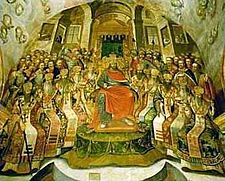- Gate Church of the Trinity (Pechersk Lavra)
-
The Gate Church of the Trinity (Ukrainian: Троїцька Надбрамна церква, Troits’ka Nadbramna tserkva; Russian: Троицкая Надвратная церковь, Troitskaya Nadvratnaya tserkov’) is a historic church of the ancient cave monastery of Kiev Pechersk Lavra in Kiev, the capital of Ukraine. Originally being built as a Kievan Rus' style church, the Gate Church of the Trinity is now decorated in the Ukrainian Baroque style, having been reconstructed many times through its history.
Contents
History
The Gate Church of the Trinity was built in 1106-1108, as part of the Pechersk Lavra fortification, atop the main entrance to the monastery. The church was founded by the grandson of the Prince of Chernigov Sviatoslav II, who renounced his princely status and became a Pechersk monk on November 17, 1106 under the name of Mykola Sviatosha.[1] Mykola spent 36 years as a monk, and founded the Monastery Hospital of the Trinity within the Lavra.
After the destruction of the Dormition Cathedral during the Mongol invasion of 1240, it became the main church of the monastery.[1] In 1462, the most complete edition of the Kiev Pechersk Paterikcon was written here.[2] In 1631, Petro Mohyla founded a school at the hospital monetary, which later was merged with the Kievan Brotherhood School.[1] Since 1701, the combined school became a Kievan Academy.
The church was studied by P. Lashkarev, I. Morgilevsky, Yu. Aseev, F. Umantsev, and S. Kilesso. In 1957-1958, restoration efforts were conducted on the church, including the restoration of lost decor, gilding of the dome, and retouching of the external oil paintings.[1]
Architecture
 The eighteenth century composition "The Council of Nicaea," by F. Pavlovskyi, I. Maksimovych, and A. Galik and others.
The eighteenth century composition "The Council of Nicaea," by F. Pavlovskyi, I. Maksimovych, and A. Galik and others.
The church is located atop the Holy Gates (Ukrainian: Святи ворота, Russian: Святые ворота), which houses the main entrance to the monstery.[3] Near the entrance, there are rooms for the gate's guards.[1] The church is wedged in between monastery walls, helping to protect the gates.[1] The outer surface of the monastery walls leading to the gates are covered in frescoes. They were completely renewed in 1900-1901 by D. Sonin and others.[1]
The Gate Church of the Trinity is divided into three naves, each of which contain spherical apses off their western side. An external stone stairway leads to the church [4][5] Several narrow window openings and the overall visual uplifting effect created a heightened sense of spiritual power.
The church is a typical Kievan Rus' construction, being built on an ancient stone church.[3] However, Kievan Rus' architectural motifs can still be seen on the southern façade of the building. The church retains its current Ukrainian Baroque exteriour after restorational works conducted in the 17th-18th centuries, done by Master V. Stefanovych.[3][5] During the reconstruction, a different cupola was installed, and new interiour paintings were made. The initial ascetic appearance was replaced with an intricate and fanciful baroque style.
In 1725, a large sixteen-candle chandelier was installed. During the 1730s-1740s, a group of artists from the monastery's iconography workshop decorated the church's interiour.[5] The church's frescoes were based on Biblical scenes, and the exteriour decor was based on Ukrainian folklore. Eighteenth century compositions by F. Pavlovskyi, I. Maksimovych, and A. Galik (which help from M. Yakubovych and I. Kadelskyi) have been preserved to this day, including: "Faces of the Holy Martyr," "The Traders Cast Out of the Temple," and "The Council of Nicaea." The names of the painters remained unknown for many years, and only recently were revealed after archival research.[5]
Interiour frescoes are a unique collection of 18th century traditional Ukrainian architecture.[1] Allegorical and historical Biblical topics are given in a noncanonical way; some of them are made with Ukrainian national ornaments.[1] Wood-carved chairs, executed in Ukrainian folk tradition, are installed along the western wall. The chairs are covered with oil paintings.[1]
Footnotes
- ^ a b c d e f g h i j Vlasenko, Petro. "Троицкая Надвратная церковь" (in Russian). Monuments of architecture of Ukrainian SSR. http://ua.vlasenko.net/_pgs/pgs-html/pgs1-050.html. Retrieved March 10, 2007.
- ^ The book is a collection of tales about the monks of the Kiev Pechersk Lavra.
- ^ a b c Malikenaite, Ruta (2003). Guildebook: Touring Kyiv. Kyiv: Baltia Druk. ISBN 966-96041-3-3.
- ^ The apses can only be seen from the centre of the church, because the exteriour walls are flat.
- ^ a b c d "Троїцька Надбрамна церква" (in Ukrainian). Wiki-Encyclopedia Kyiv. http://wek.kiev.ua/wiki/index.php/Троїцька_Надбрамна_церква. Retrieved March 8, 2007.
References
- "Троїцька Надбрамна церква (фрески)" (in Ukrainian). Wiki-Encyclopedia Kyiv. http://wek.kiev.ua/wiki/index.php/Троїцька_Надбрамна_церква_(фрески). Retrieved March 8, 2007.
- Kilesso, S.K. (1966-1970). Kiev-Pecherskaya Lavra. Iskusstvo. pp. 144. ISBN.
- Umantsev, F. (1970). Troitska nadbramna tserkva Kyievo-Pecherskoi Lavry. Mystetstvo. pp. 144. ISBN.
Coordinates: 50°26′05″N 30°33′19″E / 50.434715°N 30.555237°E
Kiev Pechersk Lavra Main buildings 
Churches All Saints · Saviour at Berestove · Exaltation of Cross · Life-Giving Spring · Nativity of the Virgin · Conception of St. Anne · Gate Church of the TrinityOther institutions Other constructions Churches and monasteries of Kiev Cathedrals Saint Sophia Cathedral · St. Volodymyr's Cathedral · Resurrection Cathedral · St. Nicholas Roman Catholic Cathedral · St. Nicholas Military Cathedral1
Churches St. Andrew's Church · St. Cyril's Church · Church of the Saviour at Berestove · Church of the Tithes · Church of the Theotokos · Troieschyna ChurchMonasteries Lavra of the Caves (Great Church · Gate Church · Refectory Church) · St. Michael's Golden-Domed Monastery · Vydubychi Monastery · Brotherhood Monastery · Trinity Monastery · Theophania Convent · Intercession Convent · Florivsky Convent · Kitaev Poustinia1Demolished structures are in italicsCategories:- Kiev Pechersk Lavra
- Churches in Kiev
- Gates
- Religious buildings completed in 1108
- 12th-century Eastern Orthodox church buildings
- Eastern Orthodox church buildings
Wikimedia Foundation. 2010.



